The Solomons Campaign: Status of the United States Fleet and Plans After Midway
This week marks the first of our Guest Bloggers for the Solomons Campaign blog project. The author is no stranger to this or several other milblogs – he is AT1(AW) Charles H. Berlemann, Jr. Hailing from the VAQ community, Charles is a student of naval history, particularly, naval aviation history and we have kept a long correspondence with him. When the Solomons Project came along he was one of the very first volunteers, offering to provide a snapshot of period of contrasts. The US had won an astounding victory at Midway, but even as the survivors of that epic battle returned to Pearl Harbor they were met with the lingering stench of bunker oil and dredged bottom mud. The ruins of the Arizona, Oklahoma and others of the once proud battle line stood as mute witness to the attack six months previous. And the question on everyone’s mind…now what?
Presented for your edification, AT1(AW) Berlemann’s post – “Status of the United States Fleet and Plans After Midway” — SJS
If you were to step into the Wayback Machine with Mr. Peabody and Sherman, traveling back to Pearl Harbor on the morning of the 7th of June 1942, to talk to Admiral Nimitz he may have covered several issues including the current status of the fleet, current ops going on in the theater, and current discussions about what to do next. The final issue would be how to seize the initiative causing the Japanese to react to us instead of the Allies reacting to the Japanese.
The current status of the Pacific Fleet is looking pretty grim. This morning [7th of June 1942] the radio reports of the torpedoing and loss of the Yorktown would arrive.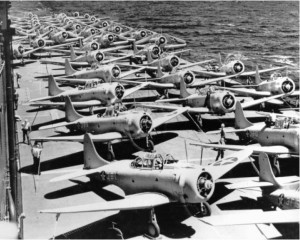 That only leaves three Allied carriers in the Pacific: USS Enterprise, CV-6; USS Hornet, CV-8; and USS Saratoga, CV-3. The Saratoga is just leaving Mare Island Naval Yard recovering from the torpedo damage she took in late May while in transit from Pearl to the West Coast. In reality the Allies only have two functional carriers deployed any place close to the Japanese fleet. However, even these two ships are nowhere near fighting trim because the air groups have been decimated by the Midway operation. Between the two ships Air Forces Pacific could build one air group, however it would be undersized on both fighters and scout bombers. Hope is on the horizon though, because Nimitz has just received the word from the CNO, Adm. King, that the USS WASP, CV-7 has just been released from Atlantic Duty with a slew of newly built ships coming to the aid of the Pacific Fleet. These ships include the USS North Carolina, BB- 55; USS Quincy, CA-39; USS San Juan, CL-54 and a slew of destroyers (all ships unfit for duty in the North Atlantic). This task force recently sortied out of Chesapeake Harbor on the 6th of June and by the morning of the 7th is sailing through the Windward Passage on route to the Panama Canal. The Saratoga is loaded to the gills with new aircraft to replace the ones lost with the Hornet and Enterprise air groups. Also there are new TBF torpedo bombers arriving to replace the TBD’s. Planes that survived and were in those two air groups are supposed to be beached at NAS Ford Island.
That only leaves three Allied carriers in the Pacific: USS Enterprise, CV-6; USS Hornet, CV-8; and USS Saratoga, CV-3. The Saratoga is just leaving Mare Island Naval Yard recovering from the torpedo damage she took in late May while in transit from Pearl to the West Coast. In reality the Allies only have two functional carriers deployed any place close to the Japanese fleet. However, even these two ships are nowhere near fighting trim because the air groups have been decimated by the Midway operation. Between the two ships Air Forces Pacific could build one air group, however it would be undersized on both fighters and scout bombers. Hope is on the horizon though, because Nimitz has just received the word from the CNO, Adm. King, that the USS WASP, CV-7 has just been released from Atlantic Duty with a slew of newly built ships coming to the aid of the Pacific Fleet. These ships include the USS North Carolina, BB- 55; USS Quincy, CA-39; USS San Juan, CL-54 and a slew of destroyers (all ships unfit for duty in the North Atlantic). This task force recently sortied out of Chesapeake Harbor on the 6th of June and by the morning of the 7th is sailing through the Windward Passage on route to the Panama Canal. The Saratoga is loaded to the gills with new aircraft to replace the ones lost with the Hornet and Enterprise air groups. Also there are new TBF torpedo bombers arriving to replace the TBD’s. Planes that survived and were in those two air groups are supposed to be beached at NAS Ford Island.
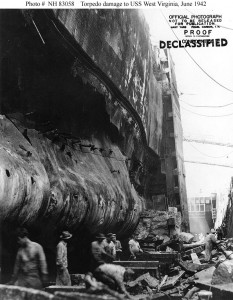 You can look out the windows of CINCPAC’s personal home and still see the salvage remains of the battleship fleet caught in the harbor on December 7th. By this time salvage crews are working 24 hours a day, three shifts, trying to repair the damage. The remains of the USS Arizona are still sitting in the harbor where she settled. The USS California, BB-44, is making preparations with a salvage crew to sail back to Puget Sound Naval Shipyard in Washington State for further and permanent repairs, along with upgrades. The USS Oklahoma, BB-37, is still turtle and the rescue operation has turned into recovery of her dead, while other
You can look out the windows of CINCPAC’s personal home and still see the salvage remains of the battleship fleet caught in the harbor on December 7th. By this time salvage crews are working 24 hours a day, three shifts, trying to repair the damage. The remains of the USS Arizona are still sitting in the harbor where she settled. The USS California, BB-44, is making preparations with a salvage crew to sail back to Puget Sound Naval Shipyard in Washington State for further and permanent repairs, along with upgrades. The USS Oklahoma, BB-37, is still turtle and the rescue operation has turned into recovery of her dead, while other 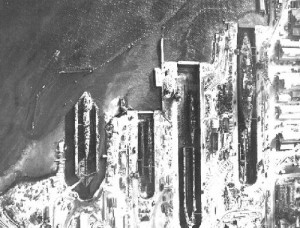 perpetrations are being made to right her. The USS Nevada, BB-36, the only battleship to get under way seven months ago is undergoing a massive refit/repair in the dry dock of Puget Sound Naval Shipyard.
perpetrations are being made to right her. The USS Nevada, BB-36, the only battleship to get under way seven months ago is undergoing a massive refit/repair in the dry dock of Puget Sound Naval Shipyard.
The Navy successfully refloated a large portion of the battle line that had been sunk on the 7th of December, but these battleships were of a slower generation and unable to keep up effectively with the fast carriers that had become the new battle line for the Pacific Fleet. These older battleships were consolidated into Task Force 1. Under the command of Admiral William Pye, they sail the trade route between the West Coast of the US and the Hawaiian Island. Their role is to intercept and destroy a Japanese invasion force. Task Force 1 is comprised of The USS Maryland, BB-46; USS Pennsylvania, BB-38; USS Tennessee, BB-43, and a slew of older cruisers and destroyers who also were incapable of keeping up with the fast carriers.
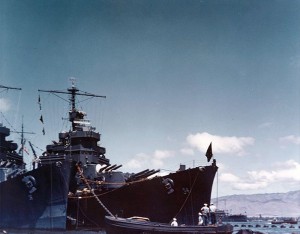 Out of the rest of the major ships damaged during the Pearl Harbor attack, the USS Helena, CL-50; has sailed to Mare Island for repairs to her torpedo damage. After that she would be part of various convoys running troops to places such as Fiji, building up the defenses of these bases in case the Japanese made moves against these islands. In July of ’42 she sailed again in the company of the Saratoga task force transporting Seabees and aircraft to Espiritu
Out of the rest of the major ships damaged during the Pearl Harbor attack, the USS Helena, CL-50; has sailed to Mare Island for repairs to her torpedo damage. After that she would be part of various convoys running troops to places such as Fiji, building up the defenses of these bases in case the Japanese made moves against these islands. In July of ’42 she sailed again in the company of the Saratoga task force transporting Seabees and aircraft to Espiritu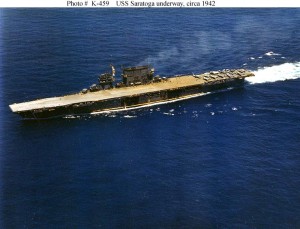 Santo. The goal is to help build that atoll as a major base with which to stage a push into the Solomon Islands. The USS Honolulu, CL-48, after receiving repairs at Mare Island Naval Yard, is also part of convoys to the Southwest Pacific Theater and the West Coast of the United States. She then sails for Kodiak, Alaska, as part of the preparations to help defend Alaska in case the MO operation was the faint or red herring in the Japanese plan. There she was running convoys from the mainland of Alaska to the various Aleutian Islands. Meanwhile, the USS Raleigh, CL-7, after receiving her refit and repair at Mare Island as well, would clear the harbor in late July 1942 and begin to help escort convoys of supplies and troops to and from the SWPAC and the West Coast.
Santo. The goal is to help build that atoll as a major base with which to stage a push into the Solomon Islands. The USS Honolulu, CL-48, after receiving repairs at Mare Island Naval Yard, is also part of convoys to the Southwest Pacific Theater and the West Coast of the United States. She then sails for Kodiak, Alaska, as part of the preparations to help defend Alaska in case the MO operation was the faint or red herring in the Japanese plan. There she was running convoys from the mainland of Alaska to the various Aleutian Islands. Meanwhile, the USS Raleigh, CL-7, after receiving her refit and repair at Mare Island as well, would clear the harbor in late July 1942 and begin to help escort convoys of supplies and troops to and from the SWPAC and the West Coast.
The rest of the fleet is busy sailing in support of the convoys slipping between the West Coast and heading to Hawaii, Australia, Alaska, Midway Island, or the various islands in between. If the ships are not doing that then they are tied up to Mare Island or Puget Sound Naval Shipyards receiving refits for this new type of warfare. The only portion of the fleet actually doing combat ops between June 7th and the first week of August is the submarine service. They are sorting out of Pearl Harbor and heading to their forward bases in places such as Brisbane or Darwin to perform operations in the SWPAC Theater. They are intercepting convoys of war materials in and out of the Dutch East Indies, intercepting troop transports, and in general doing what submarines do.
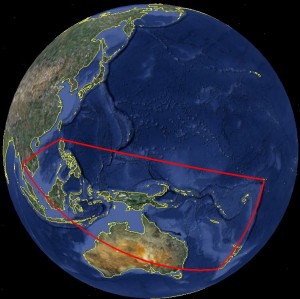 “What is the SWPAC Theater?†you ask Nimitz. “Here let me show you†he says in return. Taking you over to a map table, he draws around everything from the Samoan Island chains in the East over to the Thai/French Indochina border; from the Philippines Islands in the North to the end of New Zealand in the South. You let out a quick whistle to exclaim the size of the combat area. Nearly everything but a line stretching from Port Moresby over to New Caledonia and up to Espiritu Santo was in Japanese hands. All of this is under the command of General Douglas MacArthur as the Supreme Commander of the region. Under him is General Sir Thomas Blamey who is in charge of all Commonwealth troops in the region. This also covers the Australian and New Zealand troops deployed to New Guinea, New Zealand, and Australia. LT. General Kenney takes charge of the 5th Air Force (USAAF), which is a mix of aircraft unsuitable for combat in the European Theater of Operations and those USAAF aircraft that are able to make the retreat out of the Philippines back to Australia. His Commonwealth counterpart is the RAAF Chief of Staff, Air Vice Marshall George Jones. Marshall Jones doesn’t fare any better than General Kenney in equipment readiness. The RAAF is for the most part forward deployed in Africa in support of combat ops there or the crews are sitting in prison camps on the Malaysian Peninsula. While the aircraft are composed of modified trainers or cast off aircraft from the RAF. Vice Admiral Herbert Leary is in charge of all Allied Naval units that arrive in the theater now designated as South Pacific (or SOPAC). Finally rounding out the major officers in the SWPAC command staff is Admiral Guy Royale of the Royal Navy. He is in command of all Commonwealth naval units in the theater.
“What is the SWPAC Theater?†you ask Nimitz. “Here let me show you†he says in return. Taking you over to a map table, he draws around everything from the Samoan Island chains in the East over to the Thai/French Indochina border; from the Philippines Islands in the North to the end of New Zealand in the South. You let out a quick whistle to exclaim the size of the combat area. Nearly everything but a line stretching from Port Moresby over to New Caledonia and up to Espiritu Santo was in Japanese hands. All of this is under the command of General Douglas MacArthur as the Supreme Commander of the region. Under him is General Sir Thomas Blamey who is in charge of all Commonwealth troops in the region. This also covers the Australian and New Zealand troops deployed to New Guinea, New Zealand, and Australia. LT. General Kenney takes charge of the 5th Air Force (USAAF), which is a mix of aircraft unsuitable for combat in the European Theater of Operations and those USAAF aircraft that are able to make the retreat out of the Philippines back to Australia. His Commonwealth counterpart is the RAAF Chief of Staff, Air Vice Marshall George Jones. Marshall Jones doesn’t fare any better than General Kenney in equipment readiness. The RAAF is for the most part forward deployed in Africa in support of combat ops there or the crews are sitting in prison camps on the Malaysian Peninsula. While the aircraft are composed of modified trainers or cast off aircraft from the RAF. Vice Admiral Herbert Leary is in charge of all Allied Naval units that arrive in the theater now designated as South Pacific (or SOPAC). Finally rounding out the major officers in the SWPAC command staff is Admiral Guy Royale of the Royal Navy. He is in command of all Commonwealth naval units in the theater.
Both the Japanese and the Allied Nations had entered a lull of major combat operations following battle of Midway. The Allies were staging their forces in both Alaska and in to New Caledonia. The question was from which direction would be useful to strike from. Nimitz tells you that according to the Rainbow war plans. Either an operation out of Midway or out of Alaska would be useful and in accordance to the plan. Rainbow war plans were based on the old color coded war plans that were created starting at the turn of the century and constantly updated until the 1930’s. These war plans were created by a joint general staff board. This board was composed of both US Navy and US Army officers and they were the ones who drafted plans on everything from defending the NE United States from an English invasion from Canada (War Plan Red variant Crimson), to war with the French over their Caribbean possessions, or even war with Mexico over the border.
The biggest plan the board worked on almost constantly was titled War Plan Orange. Orange was the color assigned to Imperial Japan. It was assumed that an ever increasing amount of tension in the Pacific between the US and Japan, would lead to war. It was assumed the Japanese would land on the Philippines and attempt to gain some of their natural harbors to stage their fleet from. The basic outline of the plan was the Navy would strike out from Hawaii or San Diego to Guam. Once the fleet was established at Guam a portion of the fleet would sail between 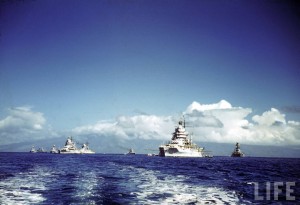 Formosa and Luzon looking for the Japanese fleet while the rest of the fleet would protect a series of troop transports would return to the Philippine to regain the lost territory. While the US Army slugged it out ashore, the US Navy would engage in the Jutland/Trafalgar style battle against the Japanese Fleet. After which the main battle line would cover the Japanese home islands enforcing a blockade and engaging in economic warfare against the Japanese merchant fleet. This would force the Japanese to surrender. Throughout the years the plans would be updated as new weapons came into use (such as submarines, aircraft, aircraft carriers, tanks, etc) and because of external efforts (such as the inter-war Naval Treaties, some of which forbid building defenses in Guam or the Philippines). Some of these would lead to drastic changes in how the plans would play out, such as no further troops or forts in Guam would lead to the development of mobile dry docks in the thirties to support the fleet in combat ops. Also the path was changed from a straight drive to the Philippines to a drive through the Central Pacific to Guam and from Guam to the Japanese Home Islands. Oh and one other major point about War Plan Orange is that they had variations depending on whether the Europeans were with us or against us. One variation had the British fleet striking out of Singapore to hunt the Japanese fleet and the US Atlantic fleet using Singapore to go to the Philippines, while the Pacific Fleet was hunting the Japanese fleet as well. The War Plans were all consolidated at the beginning of 1939 to an overall reaching plan called Rainbow War Plans. All of the various plans were consolidated and one would just need to open the chapter about the country we were fighting.
Formosa and Luzon looking for the Japanese fleet while the rest of the fleet would protect a series of troop transports would return to the Philippine to regain the lost territory. While the US Army slugged it out ashore, the US Navy would engage in the Jutland/Trafalgar style battle against the Japanese Fleet. After which the main battle line would cover the Japanese home islands enforcing a blockade and engaging in economic warfare against the Japanese merchant fleet. This would force the Japanese to surrender. Throughout the years the plans would be updated as new weapons came into use (such as submarines, aircraft, aircraft carriers, tanks, etc) and because of external efforts (such as the inter-war Naval Treaties, some of which forbid building defenses in Guam or the Philippines). Some of these would lead to drastic changes in how the plans would play out, such as no further troops or forts in Guam would lead to the development of mobile dry docks in the thirties to support the fleet in combat ops. Also the path was changed from a straight drive to the Philippines to a drive through the Central Pacific to Guam and from Guam to the Japanese Home Islands. Oh and one other major point about War Plan Orange is that they had variations depending on whether the Europeans were with us or against us. One variation had the British fleet striking out of Singapore to hunt the Japanese fleet and the US Atlantic fleet using Singapore to go to the Philippines, while the Pacific Fleet was hunting the Japanese fleet as well. The War Plans were all consolidated at the beginning of 1939 to an overall reaching plan called Rainbow War Plans. All of the various plans were consolidated and one would just need to open the chapter about the country we were fighting.
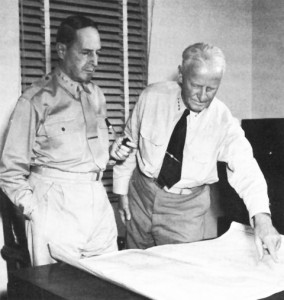 MacArthur had promised to return to the Philippines and was constantly complaining about not having enough troops, planes, ships, or supplies to do anything. Nimitz would tell you that what MacArthur should understand is that we just don’t have the fleet to be moving these “forces†he is asking for. Let alone understand that basically we are just trying to hold the line until the European conflict is resolved. If you travel to MacArthur’s offices in Brisbane, you would hear that if he had the forces he could begin to march out of Australia and back to his beloved Philippines in accordance with the Orange War Plan that he studied last time he was Army Chief of staff. Meanwhile his air forces were trading air raid for air raid with the Japanese. Japanese bombers staging out of Rabual were flying almost daily over Port Moresby trying to bomb it back the defenses. These bombers were also limiting any action into and out of the
MacArthur had promised to return to the Philippines and was constantly complaining about not having enough troops, planes, ships, or supplies to do anything. Nimitz would tell you that what MacArthur should understand is that we just don’t have the fleet to be moving these “forces†he is asking for. Let alone understand that basically we are just trying to hold the line until the European conflict is resolved. If you travel to MacArthur’s offices in Brisbane, you would hear that if he had the forces he could begin to march out of Australia and back to his beloved Philippines in accordance with the Orange War Plan that he studied last time he was Army Chief of staff. Meanwhile his air forces were trading air raid for air raid with the Japanese. Japanese bombers staging out of Rabual were flying almost daily over Port Moresby trying to bomb it back the defenses. These bombers were also limiting any action into and out of the 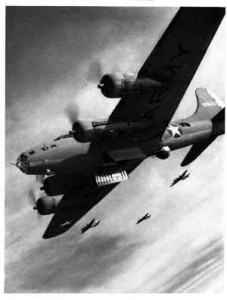 Solomon Sea. On the other side US B-17’s were flying out of Australia to Port Moresby for gas and then bombing Rabual. However, the US raids weren’t as neatly put together nor as many units as what the Japanese could stage. There were enough B-17’s to supply both the 8th Air Force in the United Kingdom and the 5th Air Force out of Brisbane. What naval forces on hand are struggling to keep Port Moresby supplied and under almost constant air attack as soon as they sail with in visual range of the harbor. The army that he is being supplied with is composed of older men of federalized US National Guard units or recruits fresh from basic training. They are arriving piece-mill from the West Coast of the US or from the interior of Australia. The majority of the US Army is going to England or being prepared for Operation Torch later this year. Again there just isn’t enough troops, ships, planes, etc to support a two front war at this time.
Solomon Sea. On the other side US B-17’s were flying out of Australia to Port Moresby for gas and then bombing Rabual. However, the US raids weren’t as neatly put together nor as many units as what the Japanese could stage. There were enough B-17’s to supply both the 8th Air Force in the United Kingdom and the 5th Air Force out of Brisbane. What naval forces on hand are struggling to keep Port Moresby supplied and under almost constant air attack as soon as they sail with in visual range of the harbor. The army that he is being supplied with is composed of older men of federalized US National Guard units or recruits fresh from basic training. They are arriving piece-mill from the West Coast of the US or from the interior of Australia. The majority of the US Army is going to England or being prepared for Operation Torch later this year. Again there just isn’t enough troops, ships, planes, etc to support a two front war at this time.
So the question is what next? As everyone is debating this in the next few weeks the Japanese make the first set of moves. First off, they land forces at Buna and begin an overland march thru Kokoda trail to try an overland capture of Port Moresby. Kokoda trail is one of two only overland trails through the Owen Stanley Mountains that cover the spine of New Guinea. Though to call it a trail is being nice, at times it is only a patch of vines and foot holes up the mountain side. The Australian commander on the ground, MGEN Basil Morris, reports this back to MacArthur’s staff; he also informs SWPAC that they are going to fight a rear guard action from Kokoda back to Port Moresby attempting to make the Japanese pay for every inch of ground they attempt to gain. MacArthur and Nimitz on the 2nd of July have a sit down with the Chairman of the new Joint Chiefs, the President, and their respective Chiefs of Staff. Both of them will outline their plans for success. Nimitz doing so in accordance with the Rainbow War plans. That is a strike through the Central Pacific, gain island bases to have the train come in behind and build support bases for the fleet. MacArthur meanwhile saying that we need to head back to the Philippines because we promised the Filipinos that he would return, he pressed that it would look wrong on us if we didn’t restore freedom to the Philippine Islands. The CJCS and the President would mulled this over before coming out saying that MacArthur would attack New Guinea and Nimitz would attack Guadalcanal as their starting points. They would then swing towards Rabaul and shut down that major deep water port and air base. Once Rabaul was neutralized, Nimitz would move in accordance with the Rainbow war plans and MacArthur would move towards the Philippines.
Epilogue
There are a number of good books that are out there if you would like to read up more about the region and about the war plans. The first one that I would recommend is “War Plan Orange: The U.S. Strategy to Defeat Japan, 1897-1945â€, by Edward S. Miller. This book covers the development of the general war planning board and in particular the development of War Plan Orange. Another good book that covers only the US Carrier operations is “The First Team and Guadalcanal Campaign†by John B. Lundstrom. Finally even though it is a little old, “Eagle against the Sun†by Ronald Spector; this book covers the whole Pacific War from Pearl Harbor to its end in 1945. Along with just these there are a slew of others ranging from unit operations, personal histories, and finally discussions about the ships/planes/tanks.
x-posted at usni-blog

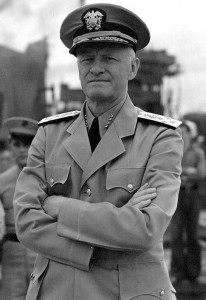
One Comment
Comments are closed.